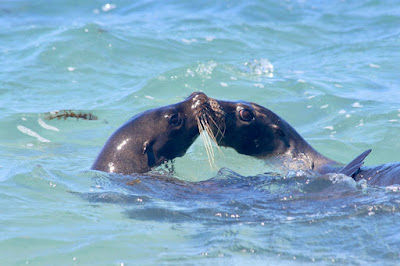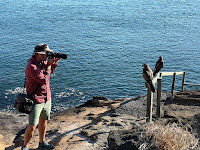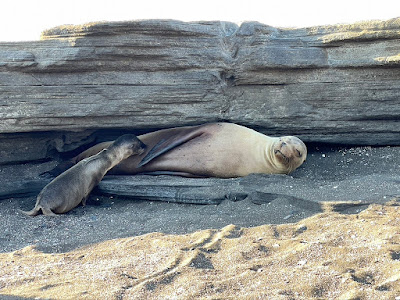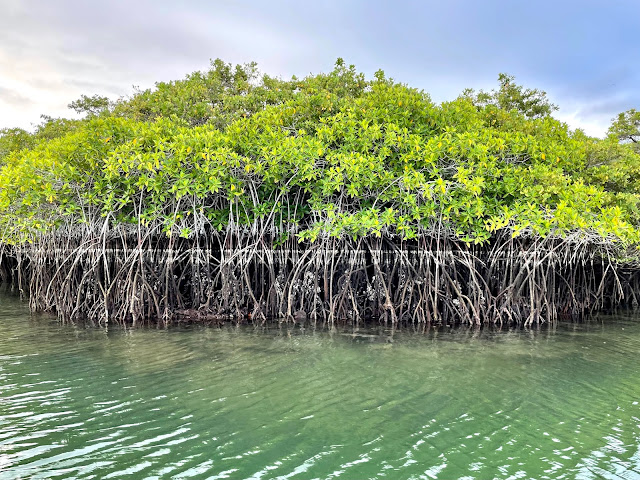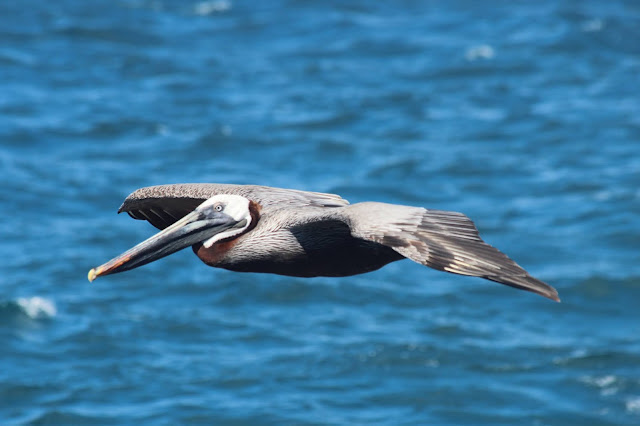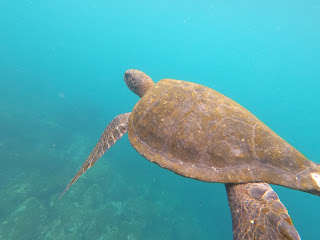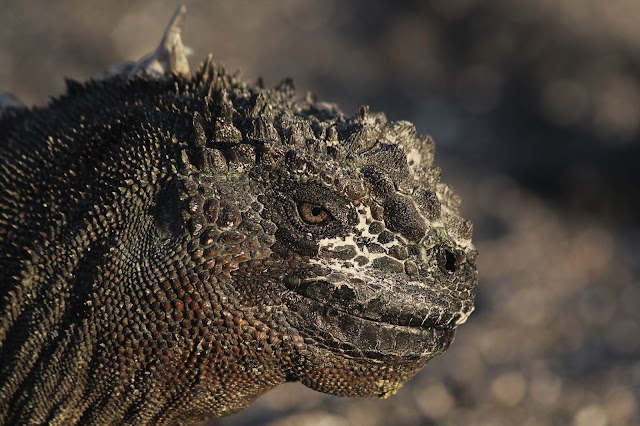August 4: Isabela
 |
| Definitely the closest I've ever been to an orca! |
 |
| They all came by to say hello! |
 |
| First tortoise sighting! |
After breakfast, we took zodiacs to the belly of the seahorse of Isabela Island. It was a wet landing onto a black sand beach known as Urbina Bay, and after changing from our water shoes to our hiking shoes, we set off to explore the island. Almost immediately, we saw a fairly small tortoise right in the middle of the path. When we walked by, he quickly retreated into his shell but when he realized it was safe, he came back out and wandered off the path.
 |
| Brain coral, now on land |
 |
| Colorful land iguana |
So the path we walked was a mixture of lava rocks, shells, and coral. There were several large land iguanas, noticeable because of their bright yellow and orange coloring. Further along, there were several large coral formations that were now high and inland because of the uplift.
When we got to the shore, we saw several sea turtles feeding in the water, as well as marine iguanas and sea lions. The sand was made up with mostly organic materials, and we found tons of shells and sea urchin skeletons.
We got back to the ship later than scheduled, and right before our Darwin talk, the pod of orcas reappeared. They were much further than before, but of course we all had to scramble out to see them.
In the afternoon, we stopped at an historic bay known as Tagus Cove. Right where we made our dry landing, two Galápagos hawks were waiting near the stairs that we needed to climb; they perched on the railing and just stared at us as we carefully climbed past. It was amazing to get so close to two raptors, who weren't at all bothered by us!Tagus Cove is one of the places where Darwin visited in 1835, and we hiked up the rim of a tuff cone past Darwin's Lake and a view across to the eastern side of Isabela. From here, you could clearly see several of the volcanoes that make up Isabela, particularly Volcan Darwin and Volcan Wolf.
 |
| Volcan Darwin, with Volcan Wolf in the distance (and Volcan Ecuador peeking in on the left) |
August 5: Isabela
Overnight, we sailed back around the head of the Isabela seahorse and on to Isla Santiago. Because there was fresh water found on this island, there was a history of humans coming to the Galápagos.
Before breakfast, we went on a scenic hike on Playa Espumilla. We walked through a mangrove forest and up for some views of the island and lagoons. It was a very different environment, with a lot more greenery and few volcanic rocks.We also encountered several birds, including a curious little mocking
bird that followed us around!
 |
| Amazing that these pelican babies still fit in the nest! |
e scorpionfish, and a penguin swimming past!
After lunch, we had a wet landing at Puerto Egas. The first thing we saw was a Galápagos hawk eating a dead blue-footed booby. Since boobies are just as large as the hawks (and with sharp beaks), the naturalists all thought the booby was most likely already injured when the hawk got it.
Our hike took us to some lovely grottoes formed by black lava that flowed into the sea. The blue-green waters were so crystal clear, and we saw sea turtles, iguanas, and sea lions swimming through the caves.
August 6: Santa Cruz
On our final day, we visited the highlands of Santa Cruz, where a the elevation is high enough that it is often in the clouds and mist - known as Garua. We visited a local ranch, "Rancho Manzanillo" to see the giant tortoises. It was drizzling when we arrived, and it was beautifully lush and green - a contrast to the black lava or desert landscape of the lower islands. We changed into rubber boots to trek around the muddy grounds. Many tortoises, both large and small, wander in and out of the ranch and National Park lands.
 |
| Giant tortoises can weigh over 770 pounds! |
Because the Galápagos were a convenient stopping point for the long sea voyages of the 16th and 17th century explorers, the population of over 250,000 giant tortoises was decimated because they were a convenient and easy food source. Tortoises could live over a year without food or water, so voyagers would throw tortoises upside-down into their cargo holds to provide themselves with fresh meat.
 |
| 250,000 of these big boys used to roam the islands! |
In addition, one of the biggest threats to the tortoise was a food shortage, caused by introduced goats that over-ate their vegetation. So while tortoises can live over 150 years, by the 1970s, there were only around 3,000 remaining in the wild in the entire Galápagos. Conservation efforts and captive breeding have now brought the population to around 30,000 (but three species - one from Floreana, one from Santa Fe, and the famous Lonesome George from Pinta Island) have gone extinct.
It was an amazing trip, and I'm so grateful to Lindblad Expeditions for the opportunity! THANKS!
 |
| Our Journey |

